

Trend of Chlorophyll in Water – Zoe's Insights. Tiny plankton drive processes in the ocean that capture twice as much carbon as scientists thought. Ken Buesseler, Woods Hole Oceanographic Institution The Research Brief is a short take about interesting academic work.
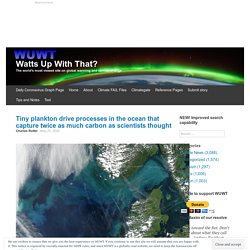
The big idea The ocean plays a major role in the global carbon cycle. The driving force comes from tiny plankton that produce organic carbon through photosynthesis, like plants on land. UCI oceanographers predict increase in phytoplankton by 2100. Machine learning Earth system model projects higher numbers in low-latitude regions University of California – Irvine Irvine, Calif. – A neural network-driven Earth system model has led University of California, Irvine oceanographers to a surprising conclusion: phytoplankton populations will grow in low-latitude waters by the end of the 21st century.
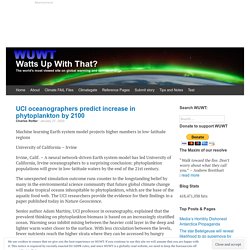
The unexpected simulation outcome runs counter to the longstanding belief by many in the environmental science community that future global climate change will make tropical oceans inhospitable to phytoplankton, which are the base of the aquatic food web. The UCI researchers provide the evidence for their findings in a paper published today in Nature Geoscience. The phytoplankton decline, is there anything to it? By Andy May We have been told that the phytoplankton population is declining rapidly around the world and, of course, the cause is climate change.
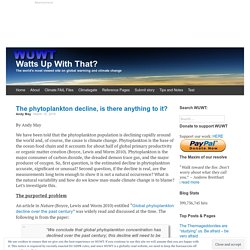
Phytoplankton is the base of the ocean food chain and it accounts for about half of global primary productivity or organic matter creation (Boyce, Lewis and Worm 2010). Phytoplankton is the major consumer of carbon dioxide, the dreaded demon trace gas, and the major producer of oxygen. So, first question, is the estimated decline in phytoplankton accurate, significant or unusual? Second question, if the decline is real, are the measurements long term enough to show it is not a natural occurrence? The purported problem An article in Nature (Boyce, Lewis and Worm 2010) entitled “Global phytoplankton decline over the past century” was widely read and discussed at the time.
They conclude that the decline is due to higher sea surface temperatures (SST). Ocean phytoplankton overview Figure 1, Phytoplankton photomicrographs. Increased carbon dioxide enhances plankton growth. Coccolithophores -- tiny calcifying plants that are part of the foundation of the marine food web -- have been increasing in relative abundance in the North Atlantic over the last 45 years, as carbon input into ocean waters has increased.
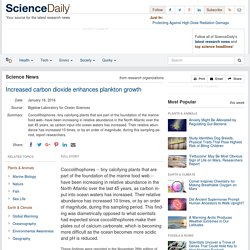
Their relative abundance has increased 10 times, or by an order of magnitude, during this sampling period. This finding was diametrically opposed to what scientists had expected since coccolithophores make their plates out of calcium carbonate, which is becoming more difficult as the ocean becomes more acidic and pH is reduced. These findings were reported in the November 26th edition of Science and based on analysis of nearly a half century of data collected by the long-running Sir Alister Hardy Foundation (SAHFOS) Continuous Plankton Recorder sampling program.
"This provides one example on how marine communities across an entire ocean basin are responding to increasing carbon dioxide levels. The Impact of Ocean Acidification on Phytoplankton Fatty Acid Production. Paper Reviewed Wang, T., Tong, S., Liu, N., Li, F., Wells, M.L. and Gao, K. 2017.
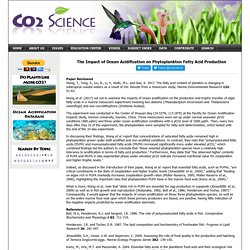
The fatty acid content of plankton is changing in subtropical coastal waters as a result of OA: Results from a mesocosm study. Marine Environmental Research 132: 51-62. Wang et al. (2017) set out to examine the impacts of ocean acidification on the production and trophic transfer of algal fatty acids in a marine mesocosm experiment involving two diatoms (Phaeodactylum tricornutum and Thalassiosira weissflogii) and one coccolithophore (Emiliania huxleyi). Study: Sea Life Benefits from Climate Change. A CO2-Induced Increase in Subtropical North Atlantic Coccolithophore Abundance. Atlantic Coccolithophores Thrive as the Air's CO2 Content Rises.
Paper Reviewed Rivero-Calle, S., Gnanadesikan, A., Del Castillo, C.E., Balch, W.M. and Guikema, S.D. 2015.
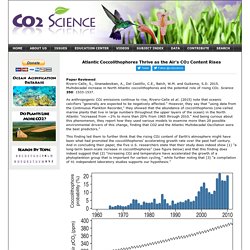
Multidecadal increase in North Atlantic coccolithophores and the potential role of rising CO2. Science 350: 1533-1537. As anthropogenic CO2 emissions continue to rise, Rivero-Calle et al. (2015) note that oceanic calcifiers "generally are expected to be negatively affected. " However, they say that "using data from the Continuous Plankton Recorder," they showed that the abundance of coccolithophores (one-celled marine plants that live in large numbers throughout the upper layers of the ocean) in the North Atlantic "increased from ~2% to more than 20% from 1965 through 2010. " And being curious about this phenomenon, they report how they used various models to examine more than 20 possible environmental drivers of this change, finding that CO2 and the Atlantic Multidecadal Oscillation were the best predictors.
" Impacts of Warming on Phytoplankton Biodiversity and Productivity. Paper Reviewed Yvon-Durocher, G., Allen, A.P., Cellamare, M., Dossena, M., Gaston, K.J., Leitao, M., Montoya, J.M., Reuman, D.C., Woodward, G. and Trimmer, M. 2015.
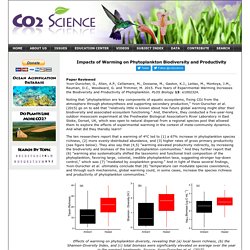
Five Years of Experimental Warming Increases the Biodiversity and Productivity of Phytoplankton. PLOS Biology 13: e1002324. Noting that "phytoplankton are key components of aquatic ecosystems, fixing CO2 from the atmosphere through photosynthesis and supporting secondary production," Yvon-Durocher et al. (2015) go on to add that "relatively little is known about how future global warming might alter their biodiversity and associated ecosystem functioning.
" Another Climate Alarm Gets Silenced: Study Shows “Tiny Algae, Hugely Resilient”! What follows is a press release from the Alfred Wegener Institute in Bremerhaven, Germany.

It turns out that microalgae — “an important source of food in the oceans” — are far more resilient to changes in ocean pH values than alarmists would like us to believe. Hat-tip: Die kalte Sonne. High CO2 and Warmth: Some Microzooplankton Absolutely Love It! Paper Reviewed Horn, H.G., Boersma, M., Garzke, J., Loder, M.G.J., Sommer, U. and Aberle, N. 2016.
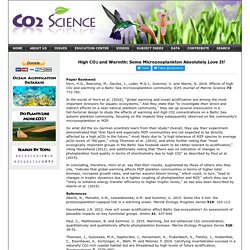
Effects of high CO2 and warming on a Baltic Sea microzooplankton community. ICES Journal of Marine Science 73: 772-782. In the words of Horn et al. (2016), "global warming and ocean acidification are among the most important stressors for aquatic ecosystems. " And they state that "to investigate their direct and indirect effects on a near-natural plankton community," they set up several mesocosms in a full-factorial design to study the effects of warming and high CO2 concentrations on a Baltic Sea autumn plankton community, focusing on the impacts they subsequently observed on the community's microzooplankton or MZP.
So what did the six German scientists learn from their study? N Fixation and Growth of Cyanobacteria in CO2-Enriched Sea Water.